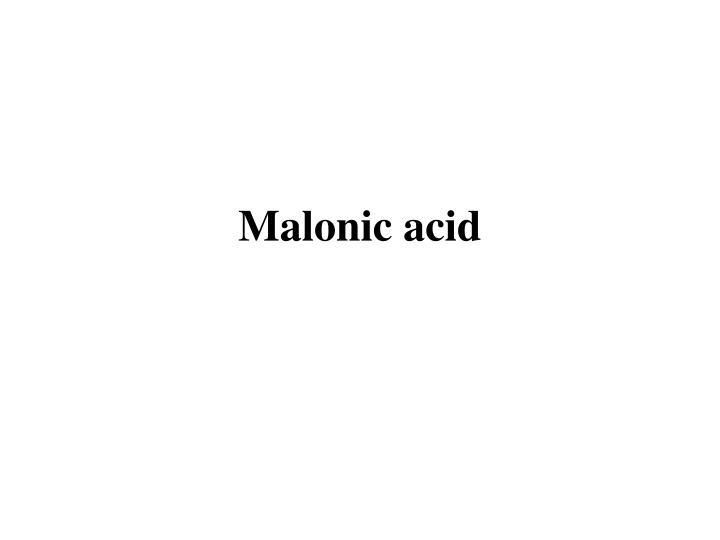
Amazing Insights into Malonic Acid: Uses, Properties & More
Discover the fascinating world of malonic acid, a dicarboxylic acid with various uses and properties. Learn about its chemical structure, preparation methods, molecular weight, and applications in industries such as pharmaceuticals, flavors, and polymers. Explore how malonic acid is produced from fruits and through fermentation, as well as its role as a building block in chemical synthesis. Unveil the versatility of malonic acid in enhancing mechanical properties, controlling acidity, and serving as a crucial component in the production of vitamins and amino acids.
Download Presentation

Please find below an Image/Link to download the presentation.
The content on the website is provided AS IS for your information and personal use only. It may not be sold, licensed, or shared on other websites without obtaining consent from the author. If you encounter any issues during the download, it is possible that the publisher has removed the file from their server.
You are allowed to download the files provided on this website for personal or commercial use, subject to the condition that they are used lawfully. All files are the property of their respective owners.
The content on the website is provided AS IS for your information and personal use only. It may not be sold, licensed, or shared on other websites without obtaining consent from the author.
E N D
Presentation Transcript
Malonic acid (IUPAC systematic name: propanedioic acid) is a dicarboxylic acid with structure CH2(COOH)2. Malonic acid is also known as Propanedioic Acid or Dicarboxymethane. Malonic acid was first prepared in the year, 1858 by the French chemist Victor Dessaignes by the oxidation of malic acid. Malonic acid is found in some fruit s viz citrus fruits. The amount of malonic acid produced from fruits through organic farming is greater than the fruits grown through conventional agriculture. Malonic acid can be produced through the fermentation of glucose.
Properties of Malonic acid C3H4O4 C3H4O4 Malonic acid Molecular Weight/ Molar Mass 104.061 g/mol Density 1.619 g/cm Boiling Point Decomposes Melting Point 135 to 137 C
Uses of Malonic acid (C3H4O4) The uses of malonic acid are listed below. Malonic acid is used as a precursor in polymers and polyester. It is used in flavours as well as the fragrance industry. It is used to control the acidity. It is used in pharmaceutical products. It is used as a cross-linking agent between potato starch and cornstarch to enhance its mechanical properties. It is used in the preparation of barbituric salt. It is used in electroplating. It is used to produce vitamin B1, vitamin B6, vitamin B2, and amino acids. It is used in chemical synthesis as a building block.
